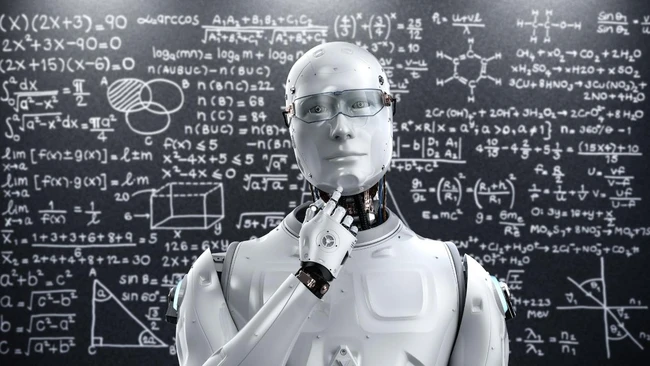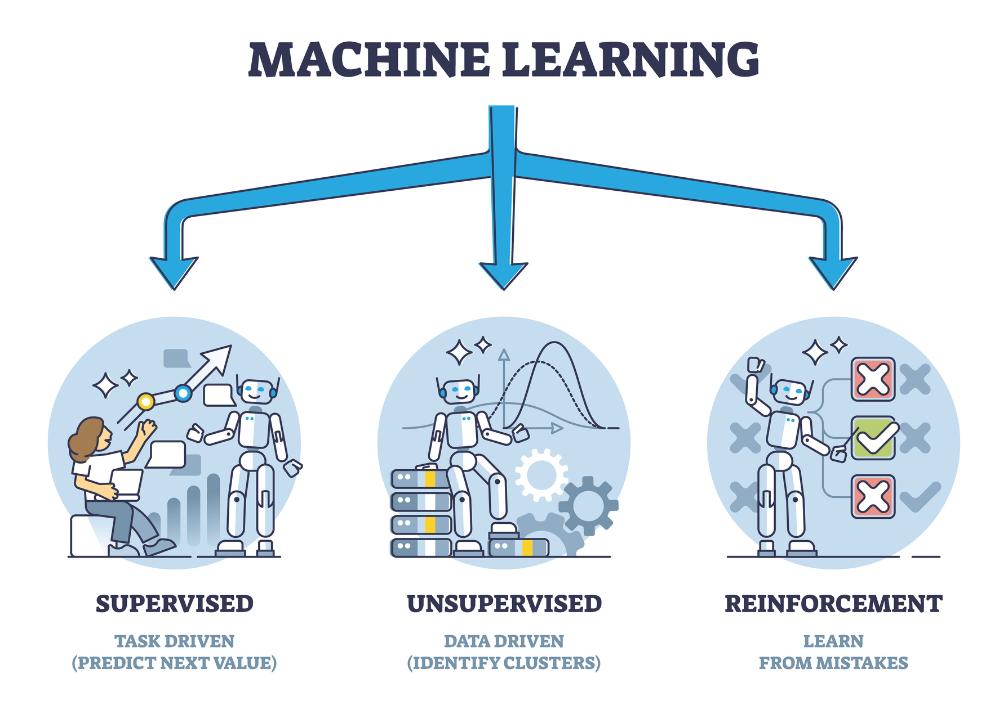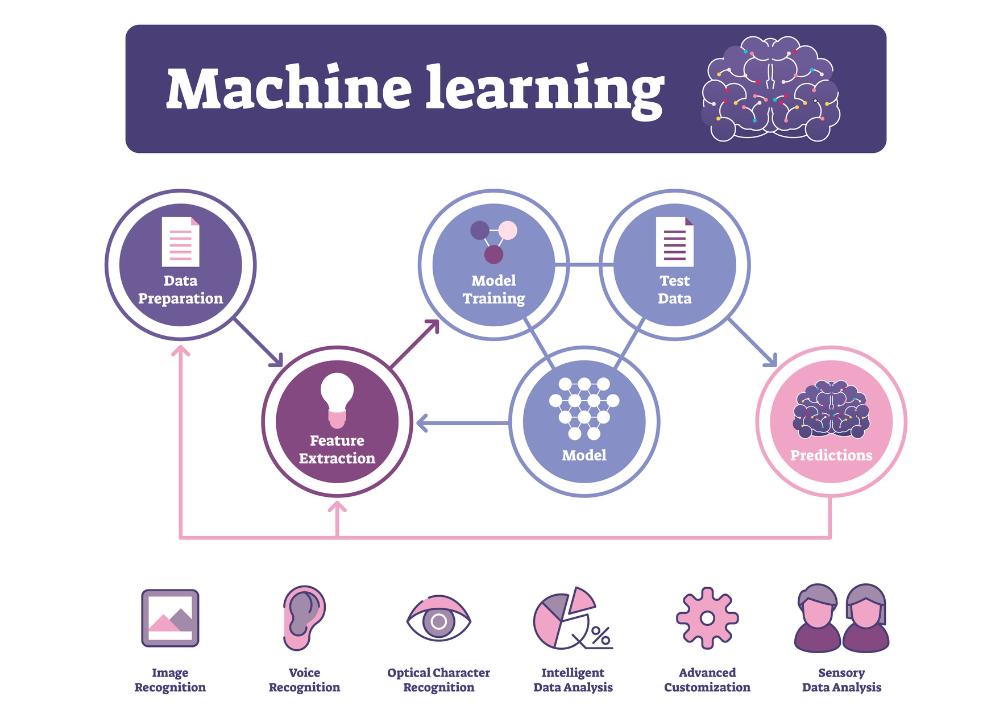
If you've ever delved into the world of artificial intelligence, you've probably heard of machine learning (ML). ML models allow computers to automatically learn from data and past experiences to identify patterns and make predictions with minimal human intervention, acting as the brains behind large language models (LLMs) like OpenAI's ChatGPT.
But what even is machine learning, and how does it work?
This article delves into the basics of Machine Learning, exploring its algorithms and models while providing real-world examples of ML models in action.
What is Machine Learning (ML)?
Machine Learning is a subset of artificial intelligence that allows computers to learn and make decisions without being explicitly programmed. Instead of relying on static instructions, machine learning systems use algorithms and statistical models to analyse data, identify patterns, and improve their performance over time.
Machine learning algorithms are trained on large datasets of labelled examples, allowing them to identify patterns and make predictions. This has made them a crucial component of many modern technologies, powering applications like facial recognition, natural language processing, and customised recommendations.
Types of Machine Learning

There are three main types of machine learning: supervised learning, unsupervised learning, reinforcement learning, and semi-supervised learning.
1. Supervised learning
This is the most common type of machine learning. In supervised learning, the algorithm is trained on a dataset of labelled data. This means that each data point in the dataset has a known output or target value. The algorithm learns by mapping the inputs to the outputs. Supervised learning algorithms are used for a variety of tasks, including classification, regression, and prediction.
2. Unsupervised Learning
This is used when the data is not labelled – meaning that the algorithm does not know the target value for each data point. The algorithm's goal is to find patterns and structure in the data on its own. Unsupervised learning algorithms are used for tasks like clustering, dimensionality reduction, and anomaly detection.
3. Reinforcement Learning
Reinforcement Learning is a type of machine learning inspired by behavioral psychology where an agent learns to make decisions by receiving feedback in the form of rewards or punishments. The agent receives rewards for taking actions that lead to desired outcomes and penalties for taking actions that lead to undesirable outcomes. The agent learns by trial and error to make decisions that maximize its rewards, allowing the algorithm to explore the environment and learn to maximize its reward over time. Reinforcement learning is used for tasks like robotics, game playing, and resource management.
Each different type of ML has its own strengths and weaknesses, and the best type for a particular task will depend on the specific goals and requirements of the task.
Machine learning (ML) Algorithms
Machine Learning algorithms are used to identify patterns and make predictions in a variety of applications, including image recognition, natural language processing, and fraud detection There are a range of different ML algorithms used in computing today, each with their own applications, benefits and limitations.
Examples of ML Algorithms
1. Linear Regression
Linear regression is a fundamental algorithm in Machine Learning, especially in supervised learning. It's used for predicting a continuous outcome based on one or more input features. The algorithm assumes a linear relationship between the input variables and the output.
Example: Predicting house prices based on features like square footage, number of bedrooms, and location.
2. Decision Trees
Decision trees are tree-like structures that make decisions based on the input features. Each node in the tree represents a decision or a test on a particular feature, and the branches represent the outcomes of these decisions.
Example: Classifying emails as spam or not spam based on characteristics like sender, subject, and content.
3. Support Vector Machines (SVM)
Support Vector Machines(SVM) is a powerful algorithm used for classification and regression tasks. It works by finding the hyperplane that best separates different classes in the feature space. SVM is particularly effective in high-dimensional spaces.
Example: Identifying whether a given image contains a cat or a dog based on visual features.
4. K-Nearest Neighbors (KNN)
K-Nearest Neighbors (KNN) is a simple yet effective algorithm for classification and regression. It classifies a new data point based on the majority class of its k-nearest neighbours in the feature space.
Example: Predicting a person's movie preference based on the preferences of their k-nearest neighbours.
5. Neural Networks
Neural networks, inspired by the human brain, consist of interconnected nodes organized into layers. Deep neural networks, or deep learning, involve multiple layers and are capable of learning complex representations. This is incredibly useful in generative AI, and many of your favourite AI chatbots probably use neural networks to some extent.
Example: Image recognition, where a neural network identifies objects in images.
Machine Learning (ML) Models

An ML model is a mathematical representation of a set of data that can be used to make predictions or decisions. It’s created by training an algorithm on a dataset of labelled examples. Once the model is trained, it can be used to make predictions or decisions on new data.
How are machine learning models created?
There are three main steps involved in creating a machine-learning model:
- Data preparation and collection: The first step is to collect a dataset of labelled data. This data can be collected from a variety of sources, such as sensors, surveys, or databases.
- Feature engineering: Once the data has been collected, it needs to be preprocessed and transformed into a format that the machine learning algorithm can understand. This process is called feature engineering.
- Model training: The final step is to train the machine learning algorithm on the data. This involves feeding the algorithm the data and allowing it to learn the patterns and relationships between the features.
Examples of ML Models
Supervised Learning Models
- Linear Regression: A statistical method that is used to model the relationship between two or more variables. It is commonly used to predict a continuous numerical output, such as the price of a house based on its size, location, and features.
- Logistic Regression: A statistical method that is used to predict a binary categorical output, such as whether or not a customer will churn. It is commonly used for classification tasks.
- Decision Tree: A tree-like structure that is used to make decisions based on a series of questions. It is commonly used for classification and regression tasks.
- Support Vector Machine (SVM): A classification algorithm that is used to find the best hyperplane to separate two classes of data. It is commonly used for tasks where the data is not linearly separable.
- Naive Bayes: A probabilistic classifier that is based on Bayes' theorem. It is commonly used for text classification tasks, such as spam filtering.
- K-Nearest Neighbors (KNN): A classification algorithm that is used to classify data points based on their similarity to other data points. It is commonly used for tasks where the data is not linearly separable.
Unsupervised Learning Models
- Principal Component Analysis (PCA): A dimensionality reduction algorithm that is used to reduce the number of features in a dataset. It is commonly used for tasks such as data preprocessing and feature engineering.
- Hierarchical Clustering: A clustering algorithm that is used to build a hierarchy of clusters of data points. It is commonly used for tasks such as image segmentation and anomaly detection.
- Anomaly Detection: A technique used to identify data points that are outliers or deviate from the norm. It is commonly used for tasks such as fraud detection and network intrusion detection.
Reinforcement Learning Models
- Q-learning: A reinforcement learning algorithm that is used to learn a policy for selecting actions in an environment. It is commonly used for tasks such as robotics and game playing.
- Deep Q-networks (DQNs): A type of reinforcement learning algorithm that is based on deep learning. It is commonly used for tasks that involve complex environments and large state spaces.
- Policy Gradient: A type of reinforcement learning algorithm that is used to learn a policy for selecting actions in an environment. It is commonly used for tasks that involve continuous state spaces.
- Actor-Critic: A reinforcement learning algorithm that combines two separate neural networks: an actor and a critic. The actor is used to select actions, and the critic is used to evaluate the actions. It is commonly used for tasks that involve complex environments and large state spaces.
Real-World Examples of ML in Action

Machine learning (ML) is already a part of our day-to-day lives, and its impact is only going to grow in the future. Here are some real-world examples of how ML is being used right now:
- Healthcare. Machine Learning is making significant contributions to the healthcare sector. Algorithms are being used to analyze medical images, predict disease outbreaks, and assist in diagnosing various conditions. ML-powered predictive models can also help identify patients at risk of certain diseases based on their medical history and lifestyle.
- Finance. In finance, Machine Learning helps with fraud detection, algorithmic trading, and credit scoring. Fraud detection models can analyze patterns in transaction data to identify unusual behaviour and flag potential fraudulent activity. Algorithmic trading also relies on complex ML models to make split-second decisions in financial markets.
-
Retail. E-commerce platforms rely on Machine Learning for personalized recommendations, demand forecasting, and customer service. ML-powered Recommendation systems can analyse user behaviour to suggest products that align with individual preferences. Demand forecasting models help optimize inventory management, ensuring products are available when customers need them.
-
Autonomous Vehicles. The automotive industry is incorporating Machine Learning in the development of autonomous vehicles. These vehicles use sensors and cameras to gather real-time data, and ML algorithms process this data to make decisions on navigation, obstacle avoidance, and traffic interactions.
- Natural Language Processing (NLP). NLP is a branch of Machine Learning focused on enabling computers to understand, interpret, and generate human language. Virtual assistants like Siri and Alexa, language translation services, and sentiment analysis tools all rely on NLP algorithms to process and generate human-like text.
These are just a few examples of the many ways that ML is being used to make our lives easier, safer, and more enjoyable. As ML continues to develop, we can expect to see even more innovative and transformative applications in the years to come.
The Future of Machine Learning
As technology continues to evolve, Machine Learning is expected to advance in exciting ways. ML is already being used in a wide variety of industries, and its adoption is only going to grow in the future.
Researchers are also constantly developing new and more powerful ML algorithms. These algorithms will be able to learn from more complex data, make more accurate predictions, and operate on more powerful hardware.
As ML models become more complex, it is becoming increasingly important to be able to explain and interpret their decisions. This will help to build trust in ML systems and ensure that they are used ethically and responsibly.
Looking to the future, the integration of Machine Learning into everyday life is likely to continue, bringing about new possibilities and transforming the way we live and work.












